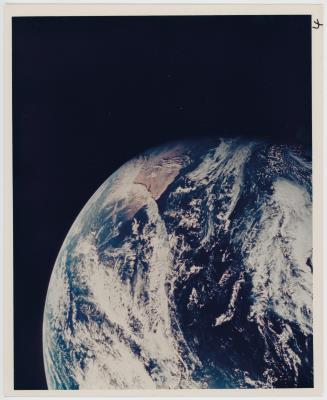William Anders (Apollo 8)
The disk of the Earth first seen by humans, 21-27 December 1968
Vintage chromogenic print on fiber-based paper, printed 1968, (NASA AS8-16-2588, inverted), with "A KODAK PAPER" watermark on verso, 20,3 x 25,4 cm
About 3 hours and 30 minutes after launch, the crew of Apollo 8 was already further from Earth than any humans before them and experienced a never before seen view of the disk of the Earth from 6,500 nautical miles away. The photograph was taken by William Anders with the 80mm lens. The Atlantic Ocean and the west coast of Africa are clearly visible.
From the mission transcript when the photograph was taken:
003:35:44 Borman: We see the Earth now, almost as a disk.
003:35:49 Collins (Mission Control): Good show. Get a picture of it.
003:35:51 Borman: We are.
003:35:54 Borman: Tell Conrad he lost his record.
003:35:59 Lovell: We have a beautiful view of Florida now. We can see the Cape, just the point.
003:36:05 Collins: Roger.
003:36:06 Lovell: And at the same time, we can see Africa. West Africa is beautiful. I can also see Gibraltar at the same time I’m looking at Florida.
003:36:20 Collins: Sounds good. Get a picture of it. What window are you looking out?
003:36:29 Lovell: The center window.
003:36:30 Collins: Roger. [Pause.]
003:36:39 Collins: Are your windows clear so far? [Long pause.]
003:36:39 Public Affairs Officer (Mission Control): This is Apollo Control, Houston. The crew seems to be pretty settled down after their Translunar Injection burn and they are getting some time on the window. We just heard Jim Lovell report he could see Florida perfectly. By the way, they are at about 6,500 [nautical] miles [12,000 km] above the Earth now. He said he had a beautiful view of Florida and then his gaze roamed a little bit to the other side of the window and he could also see Gibraltar. The crew reminded the Control Center here that Pete Conrad and Dick Gordon would have to step aside. Their altitude record (1,368 km on Gemini 11) has been exceeded.
Literature:
LIFE, 10 January 1969, ppg. 22-23; The View from Space: American Astronaut Photography, 1962–1972, Schick and Van Haaften, pg. 94; Airborne Camera: The World from the Air and Outer Space, Newhall, pg. 123; Apollo: The Epic Journey to the Moon, Reynolds, pg. 106.
Expertin: Mag. Eva Königseder
 Mag. Eva Königseder
Mag. Eva Königseder
+43-1-515 60-421
eva.koenigseder@dorotheum.at
27.09.2023 - 14:56
- Erzielter Preis: **
-
EUR 1.430,-
- Schätzwert:
-
EUR 1.200,- bis EUR 1.800,-
- Startpreis:
-
EUR 600,-
William Anders (Apollo 8)
The disk of the Earth first seen by humans, 21-27 December 1968
Vintage chromogenic print on fiber-based paper, printed 1968, (NASA AS8-16-2588, inverted), with "A KODAK PAPER" watermark on verso, 20,3 x 25,4 cm
About 3 hours and 30 minutes after launch, the crew of Apollo 8 was already further from Earth than any humans before them and experienced a never before seen view of the disk of the Earth from 6,500 nautical miles away. The photograph was taken by William Anders with the 80mm lens. The Atlantic Ocean and the west coast of Africa are clearly visible.
From the mission transcript when the photograph was taken:
003:35:44 Borman: We see the Earth now, almost as a disk.
003:35:49 Collins (Mission Control): Good show. Get a picture of it.
003:35:51 Borman: We are.
003:35:54 Borman: Tell Conrad he lost his record.
003:35:59 Lovell: We have a beautiful view of Florida now. We can see the Cape, just the point.
003:36:05 Collins: Roger.
003:36:06 Lovell: And at the same time, we can see Africa. West Africa is beautiful. I can also see Gibraltar at the same time I’m looking at Florida.
003:36:20 Collins: Sounds good. Get a picture of it. What window are you looking out?
003:36:29 Lovell: The center window.
003:36:30 Collins: Roger. [Pause.]
003:36:39 Collins: Are your windows clear so far? [Long pause.]
003:36:39 Public Affairs Officer (Mission Control): This is Apollo Control, Houston. The crew seems to be pretty settled down after their Translunar Injection burn and they are getting some time on the window. We just heard Jim Lovell report he could see Florida perfectly. By the way, they are at about 6,500 [nautical] miles [12,000 km] above the Earth now. He said he had a beautiful view of Florida and then his gaze roamed a little bit to the other side of the window and he could also see Gibraltar. The crew reminded the Control Center here that Pete Conrad and Dick Gordon would have to step aside. Their altitude record (1,368 km on Gemini 11) has been exceeded.
Literature:
LIFE, 10 January 1969, ppg. 22-23; The View from Space: American Astronaut Photography, 1962–1972, Schick and Van Haaften, pg. 94; Airborne Camera: The World from the Air and Outer Space, Newhall, pg. 123; Apollo: The Epic Journey to the Moon, Reynolds, pg. 106.
Expertin: Mag. Eva Königseder
 Mag. Eva Königseder
Mag. Eva Königseder
+43-1-515 60-421
eva.koenigseder@dorotheum.at
|
Käufer Hotline
Mo.-Fr.: 10.00 - 17.00
kundendienst@dorotheum.at +43 1 515 60 200 |
| Auktion: | The Beauty of Space - Iconic Photographs of Early NASA Missions |
| Auktionstyp: | Online Auction |
| Datum: | 27.09.2023 - 14:56 |
| Auktionsort: | Wien | Palais Dorotheum |
| Besichtigung: | Online |
** Kaufpreis inkl. Käufergebühr und Mehrwertsteuer
Es können keine Kaufaufträge über Internet mehr abgegeben werden. Die Auktion befindet sich in Vorbereitung bzw. wurde bereits durchgeführt.

